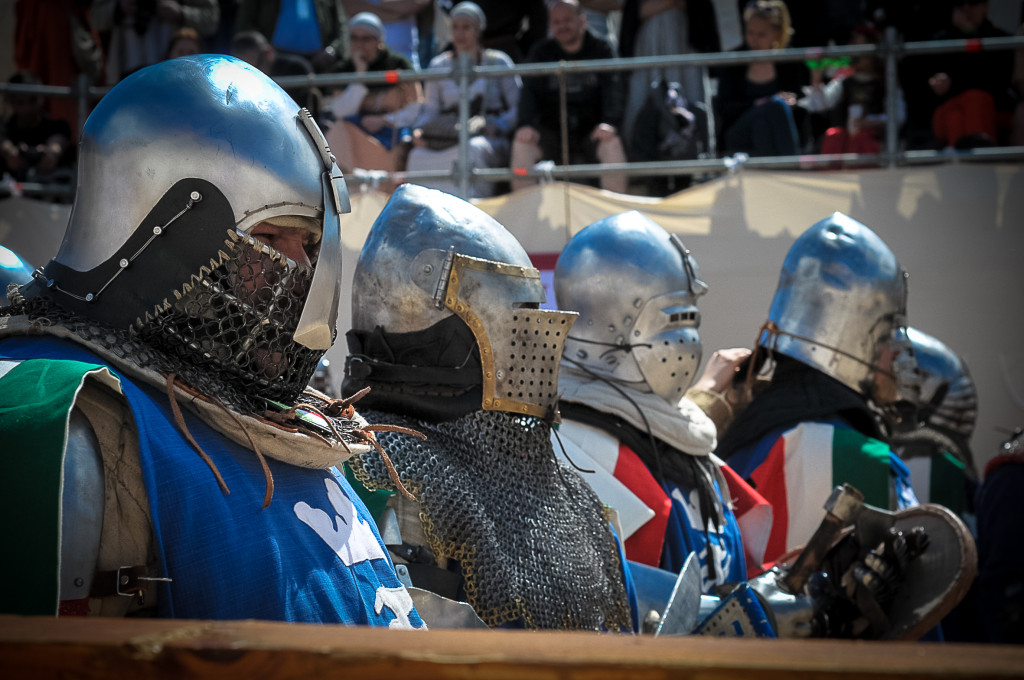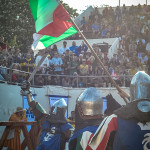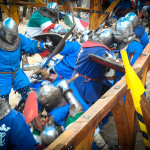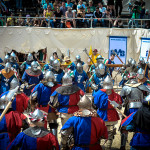The 6th edition of the World Championship of Medieval Combat took place this year in Prague. On the field also the Italian national team
At first sight, a sort of late spring Carnival reawakening, or a typical parade in period costumes, that often take place in many historic European cities. But then we soon realized that the Battle of Nations – the tournament of battles, wearing medieval costumes, that had just taken place in Prague and at its 6th edition – is in fact a real sport event, with many strict and well-defined rules, say the organizers.
The chronicle of the Battle of Nations in Prague had begun with a parade of the teams, in Hradčanské náměstí, in the Castle district. The colourful parade involving several hundred warriors, dressed up in medieval costumes (late 14th century – early 15th century), represented thirty countries around the world, including the United States, Argentina, Mexico, Switzerland, Australia and New Zealand. There was also the Italian team, represented by AICM – the Italian Association of Medieval Combat.
 The tournaments took place the following day, in the beautiful surroundings of Petřín hill, overlooking the impressive complex of the Prague Castle. In front of the terraces full of spectators, the four-day event took place in a warm and friendly climate and was divided into three categories: the one on one, five against five and 21 against 21. The latter turned out to be the most exciting, with 42 warriors confronting each other on the field in a thrilling melee of flashing armour.
The tournaments took place the following day, in the beautiful surroundings of Petřín hill, overlooking the impressive complex of the Prague Castle. In front of the terraces full of spectators, the four-day event took place in a warm and friendly climate and was divided into three categories: the one on one, five against five and 21 against 21. The latter turned out to be the most exciting, with 42 warriors confronting each other on the field in a thrilling melee of flashing armour.
The competition, though, has an inevitable violent aspect to it, because it is a contact sport. The fighting takes place with brutal hand to hand clashes, practically brandishing true weapons and by striking resolute blows. The goal is to knock your opponent to the ground and thus neutralize him. The risk of causing an injury is always present, even if the athletes are wearing armour, iron gloves and miscellaneous stuffing, and the fact that the tips of the swords have been smoothened and rounded off.
On the field, the level of adrenaline is sky-high, also induced by the great enthusiasm and passion of the spectators – many of whom in the wake of the competing nations – in a din of clashing armour. However violent the clashes are, they are carried out with a sense of loyalty and respect towards the opponent, with backslapping and handshaking between the competitors at the end of the contest.
Also this year, as usual, the winners were the national Russian and Ukraine teams. In both these countries, this particular sport was very popular also during the USSR period, and this is perhaps one of the main reasons for such dominance. It seems that in Russia this discipline is sponsored directly by the state.
For the Italian national team – that included also the women’s team, the 2015 Battle of the Nations was a year of confirmation and overall positive results, as Davide Rospi and Massimo Borgna – representatives of AICM – explained. In the five against five contest, the Azzurri had to surrender only to the superiority of the Russian and Ukrainian opponents. A more articulated judgment, however, for the 21 against 21 and one on one categories: on the one hand an impression that there is still work to be done to achieve higher results, on the other, the certainty that they are heading in the right direction.







